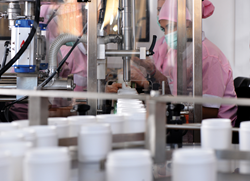Award winning UK micro engineering specialist, Micropore Technologies, has just launched a high throughput system capable of continuous manufacture of high quality emulsions in industrial quantities, with tunable control of particle size distribution.
“The Micropore CXF-1 is the final piece of the jigsaw in Micropore’s product line-up and removes the last barrier to membrane emulsification scale-up for mass manufacturing,” says Dai Hayward, Micropore’s CEO.
The ability to create high quality emulsions formed from uniform size droplets, all with the same performance, creates inherently more stable products reducing creaming and sedimentation. Less emulsifier or surfactant is required, reducing raw material costs. And, with a much lower shear force, sensitive materials are able to be more gently processed without damage – significantly reducing wastage.
The benefits that clients see from membrane emulsification include; elimination of waste (typically a minimum of 10% using conventional means); 30% reduction in energy; reduction in regulatory burden; high ROI; and a significant reduction in equipment footprint.
The new unit, CXF-1, has an aseptic standard twin (AXF-1) perfect for the cosmetic, food and pharmaceutical industries and, like the CXF-1, features a robust and reliable precision-engineered tubular membrane with no moving parts. The substance to be dispersed in the emulsion is pumped through the patented membrane tube, passing through the laser drilled micro pores whilst the continuous phase substance flows along the tube providing the shear force necessary to deform and detach the droplets as they form through the membrane.
It is the precise size and distribution of the pores in the membrane that enable the production of near mono-dispersed droplets at precise sizes of the client’s choice from 15 microns up to 1 mm. Adjusting the flow rates of each substance allows different droplet sizes to be created and even at high flow rates the coefficient of variation remains low at around 10-15%.
Micropore offers a lab unit for initial scoping studies. The results from this translate directly to an extremely flexible development unit for optimisation of operating parameters before using the data generated to customise the CXF-1 for full-scale manufacturing duties.
Emulsions produced through the Micropore system can be post-processed and turned into microcapsules for a variety of active delivery systems, with the highly uniform capsule sizes produced behaving in exactly the same way, thus reducing unwanted rupture variability.




